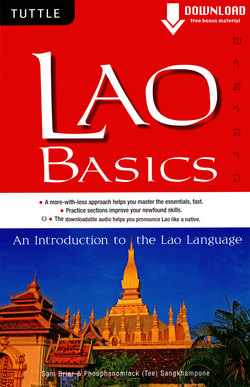Читать книгу Lao Basics - Sam Brier - Страница 7
ОглавлениеIntroduction
Why Lao Basics?
Some readers may wonder why this book is not called Laotian Basics, or perhaps even Laos Basics. The English words Laos and Laotian are derived from the Lao language, but they are not accurate transliterations. The French added the "s" to Lao, which is the correct pronunciation of the country as well as the language and the people. For example: "Lao people speak Lao in Lao." Hence, we have called this book Lao Basics.
Lao Basics teaches conversational Lao from the very beginning with an emphasis on reading and writing. It follows the same simple, effective learning format as Easy Thai by Gordon Allison, which has remained popular and in print since its publication in 1968.
Students of Thai will find Lao quite simple, as much of these two languages are the same or very similar. Likewise, after learning Lao, Thai (with a more complex alphabet) will be much easier to study. These languages derive from Sanskrit and share many of the same consonants, vowels, vocabulary and grammar. A Thai speaker learning Lao would be comparable to a French speaker studying Italian or vice versa.
Lao Basics is organized so that you will first learn to read, write, speak and comprehend the 26 consonants in their tonal classes. Once you have mastered these, you will study the 28 vowels in subsets. Within each vowel grouping, you will learn vocabulary, conversational phrases, alphabetical order and sentence structure through exercises that grow more challenging as your vocabulary increases.
As you progress through Lao Basics, vocabulary from previous lessons will be repeated regularly and your command of the written and spoken language will steadily improve.
And you can do all of this on your own. Each chapter's Lao words and exercises have been recorded on the accompanying CD, and all of the exercise answers are in the back of the book.
How to Use This Book
The Lao alphabet may look formidable, but it contains clear rules, which make learning to read and spell in Lao much easier than in English. For example, consonants and vowels are read as they are written and vice versa, as in Spanish; i.e., pronunciation does not change. And even though vowel placement may look confusing to the novice, vowels do not change location. The logical design of the written language greatly helps to learn the spoken language, and Lao Basics takes advantage of this in its layout.
In Lao Basics, the 26 Lao consonants are broken down into three classes rather than taught in alphabetical order. This follows the traditional teaching format of Lao, and we also follow this method because each grouping references a tonal category.
To use Lao Basics effectively, plan to move on to the next chapter only after you are confident that you have mastered the previous one. Practice writing each letter as you say it until you are 75% sure that you can recognize, say and write each correctly from memory; then move on to the exercises for reinforcement. And don't forget to listen to the audio CD for correct pronunciation. The answers to all exercises are at the back of the book.
Like English, Lao is read left to right and follows the Subject-Verb-Object word order. Additionally, most Lao letters are pronounced just like sounds that exist in English.
Lao differs from English in other ways, however. Lao has relatively little grammar, no plurals, few articles, and regularly leaves out the subject pronoun (I, He, She...) at the beginning of sentences when the context is understood. In this sense Lao can be much easier to learn than other languages.
Other aspects are more difficult to get used to. For example, there are no spaces between words in the written language; a special word is added to the end of sentences (baw), rather than inflection, that turns statements into questions; some vowel sounds are unfamiliar to the English speaker, and certain vowels are placed to the left of consonants, while other vowels are placed to the right, above and below. But, have no fear—unlike English, the rules are easy to follow, and each vowel combination is only pronounced one way.
A note on writing Lao script: Most consonants and some vowels start with a small loop. In order to write the letter correctly, start with the loop at one end of the letter and follow the letter through to the other end. Here is an example:
Each chapter contains explanations where necessary to make your learning experience more enjoyable, so let's leave it at that and get started.
